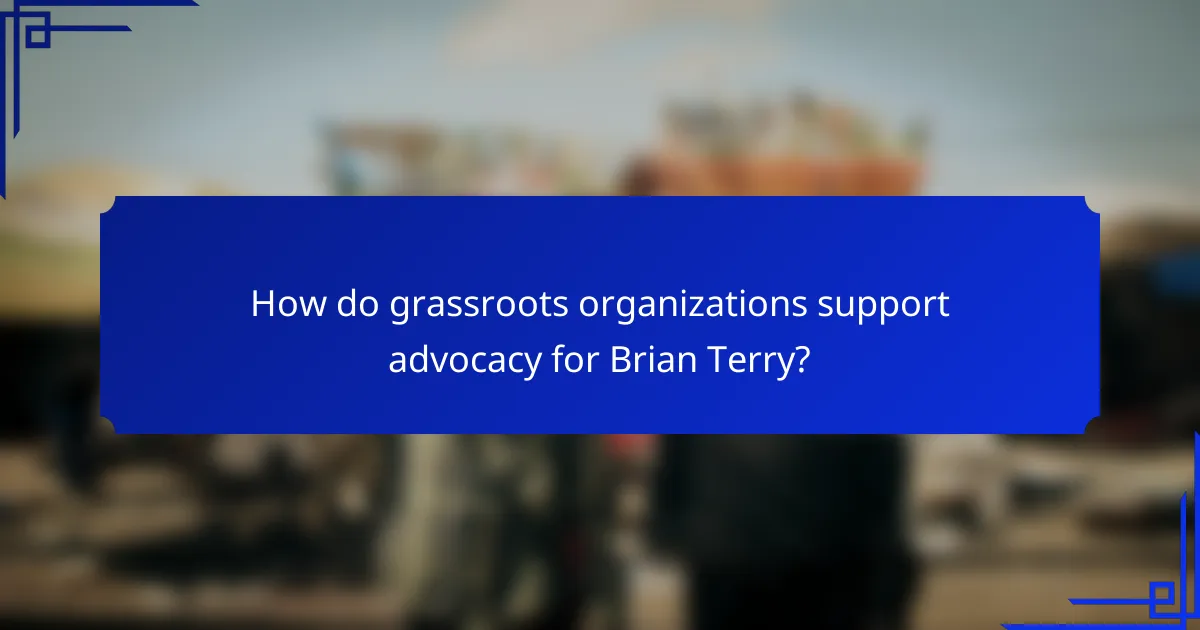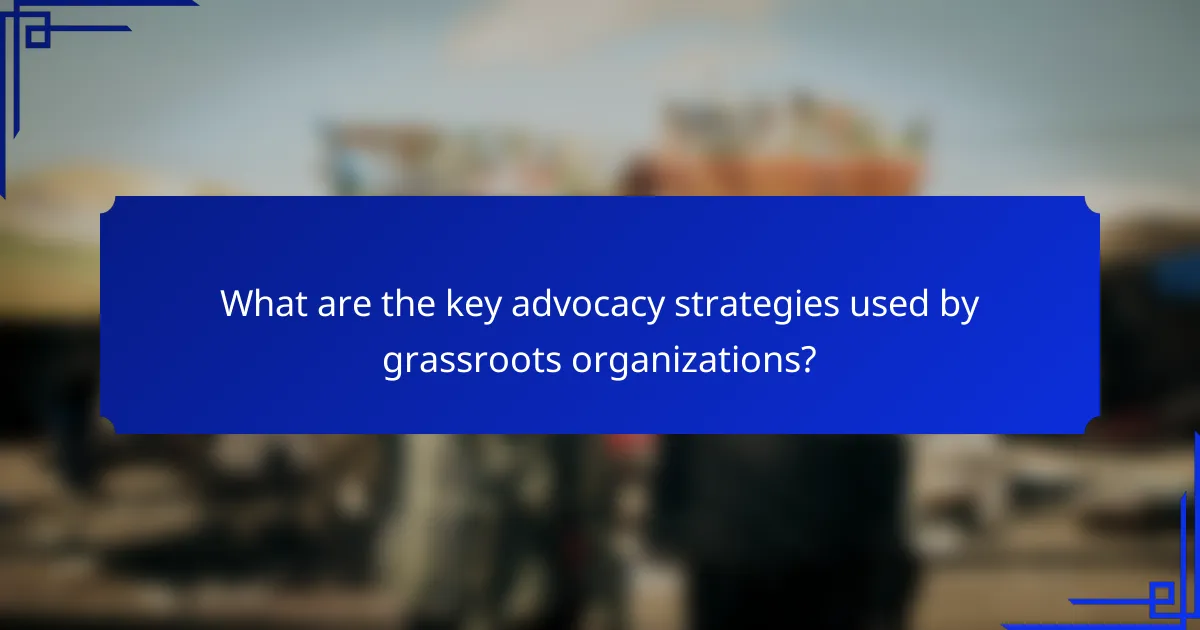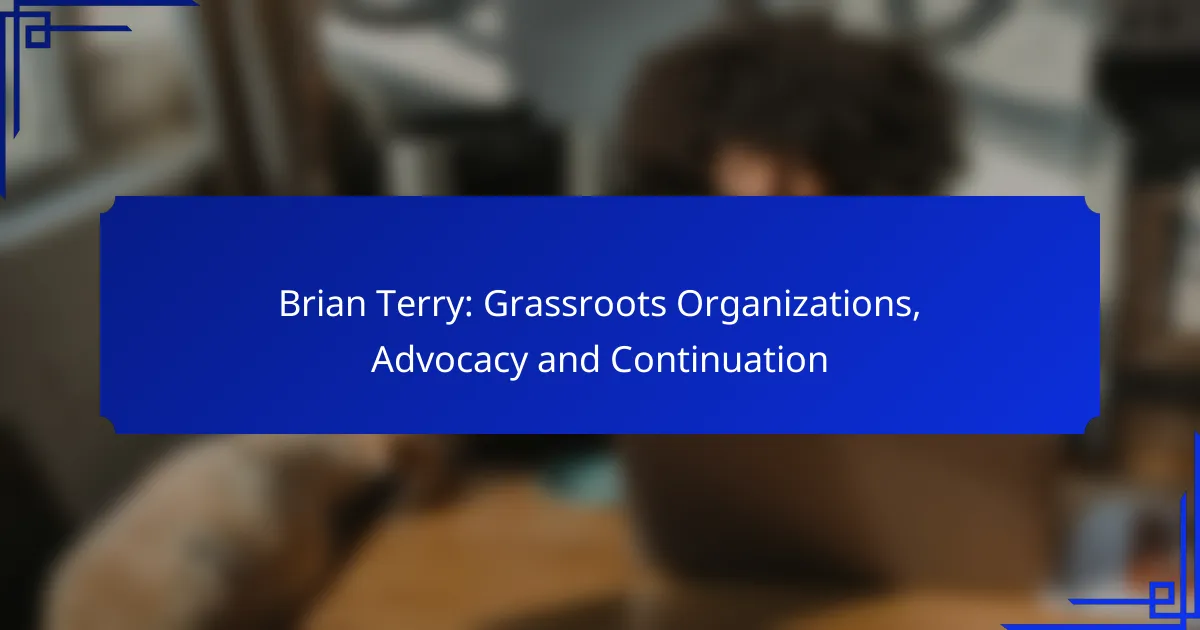Grassroots organizations are vital in advocating for Brian Terry, effectively mobilizing community support and raising awareness about critical issues surrounding border security and immigration reform. By employing strategies such as public awareness campaigns and grassroots lobbying, these organizations create a unified voice that influences policy and fosters accountability. Individuals can contribute to this advocacy by joining these organizations, participating in community events, and volunteering, all of which help honor Terry’s legacy and promote necessary reforms.

How do grassroots organizations support advocacy for Brian Terry?
Grassroots organizations play a crucial role in advocating for Brian Terry by mobilizing community support and raising awareness about issues related to border security and immigration reform. They engage local populations to create a collective voice that influences policy and fosters accountability.
Community engagement initiatives
Community engagement initiatives are essential for grassroots organizations to connect with residents and build a strong support network. These initiatives often include town hall meetings, workshops, and outreach programs that educate the public about Brian Terry’s case and related advocacy efforts.
For example, organizations may host events that allow community members to share their stories and experiences, fostering a sense of solidarity and urgency around the issues at hand. Engaging local leaders and influencers can amplify these efforts, making the advocacy more impactful.
Policy influence through local campaigns
Grassroots organizations influence policy by launching local campaigns that highlight the need for legislative changes. These campaigns often involve petitions, letter-writing drives, and coordinated efforts to meet with local representatives to discuss Brian Terry’s case and broader immigration issues.
By organizing these campaigns, grassroots groups can effectively pressure policymakers to take action. They may focus on specific legislative proposals, urging lawmakers to consider reforms that enhance border security and accountability in law enforcement practices.
Collaboration with national organizations
Collaboration with national organizations enhances the effectiveness of grassroots advocacy for Brian Terry. By partnering with larger entities, local groups can access resources, expertise, and broader networks that amplify their message.
Such collaborations may involve joint campaigns, shared funding opportunities, and coordinated lobbying efforts. National organizations can provide training and support to grassroots activists, helping them to develop effective strategies for advocacy and outreach.

What are the key advocacy strategies used by grassroots organizations?
Grassroots organizations employ various advocacy strategies to mobilize community support and influence policy changes. Key strategies include public awareness campaigns, grassroots lobbying efforts, and utilizing social media for outreach.
Public awareness campaigns
Public awareness campaigns aim to inform and educate the community about specific issues or causes. These campaigns often utilize flyers, community events, and local media to spread their message effectively.
Successful campaigns typically focus on clear, relatable messaging that resonates with the target audience. For example, a campaign addressing environmental concerns might highlight local pollution issues and encourage community action.
Grassroots lobbying efforts
Grassroots lobbying involves mobilizing community members to advocate directly to policymakers. This can include organizing meetings with local representatives, writing letters, or participating in rallies to express collective concerns.
Effective grassroots lobbying requires understanding the political landscape and building relationships with decision-makers. Organizations often provide training and resources to empower individuals to engage confidently in the lobbying process.
Utilizing social media for outreach
Social media serves as a powerful tool for grassroots organizations to reach a wider audience quickly and cost-effectively. Platforms like Facebook, Twitter, and Instagram allow organizations to share information, mobilize supporters, and engage in real-time discussions.
To maximize impact, organizations should create compelling content that encourages sharing and interaction. Regular updates, engaging visuals, and calls to action can significantly enhance outreach efforts and foster community involvement.

How can individuals get involved in advocacy for Brian Terry?
Individuals can engage in advocacy for Brian Terry by joining grassroots organizations, participating in community events, and volunteering for campaigns. These actions help raise awareness and support for issues related to his legacy and the broader context of border security and law enforcement reform.
Joining local advocacy groups
Joining local advocacy groups is a direct way to contribute to the cause surrounding Brian Terry. These organizations often focus on border security, immigration reform, and law enforcement accountability, providing a platform for collective action.
To find a group, search online for organizations in your area that align with these issues. Many groups welcome new members and offer training sessions to help you understand the advocacy landscape.
Participating in community events
Community events are excellent opportunities to engage with others who are passionate about advocacy for Brian Terry. These events can include rallies, educational forums, and town hall meetings where you can learn more and voice your opinions.
Look for local events through social media platforms or community bulletin boards. Participating not only raises awareness but also helps build a network of like-minded individuals committed to the cause.
Volunteering for campaigns
Volunteering for campaigns related to Brian Terry’s advocacy can significantly amplify your impact. Campaigns often seek volunteers for various roles, including canvassing, phone banking, and organizing events.
Reach out to local political candidates or advocacy organizations to inquire about volunteer opportunities. Even a few hours a week can make a difference in spreading the message and mobilizing support.

What are the challenges faced by grassroots organizations?
Grassroots organizations encounter several significant challenges that can hinder their effectiveness and sustainability. Key issues include funding limitations, political opposition, and barriers to community engagement, each of which can affect their ability to advocate for change and mobilize support.
Funding limitations
Many grassroots organizations struggle with securing adequate funding to support their initiatives. This often results from a reliance on small donations, grants, or volunteer efforts, which can be inconsistent and insufficient for long-term projects.
To navigate funding limitations, organizations should diversify their funding sources by exploring partnerships with local businesses, applying for grants from foundations, and utilizing crowdfunding platforms. Establishing a clear budget and financial plan can also help in managing resources effectively.
Political opposition
Grassroots organizations frequently face political opposition that can undermine their advocacy efforts. This opposition may come from local government entities, political groups, or influential stakeholders who disagree with the organization’s mission or goals.
To counter political challenges, organizations should engage in strategic lobbying, build coalitions with like-minded groups, and leverage public support to amplify their message. Understanding the political landscape and maintaining open lines of communication with policymakers can also be beneficial.
Community engagement barriers
Engaging the community is essential for grassroots organizations, yet they often encounter barriers such as apathy, lack of awareness, or cultural differences. These factors can limit participation and support for their initiatives.
To overcome these barriers, organizations should focus on building trust within the community through transparent communication and inclusive practices. Hosting events, workshops, and outreach programs can help raise awareness and foster a sense of ownership among community members, encouraging greater involvement in advocacy efforts.

What role do national organizations play in supporting grassroots efforts?
National organizations play a crucial role in supporting grassroots efforts by providing essential resources, fostering collaborations, and amplifying the voices of local advocates. Their involvement can significantly enhance the effectiveness and reach of community initiatives.
Providing resources and training
National organizations often offer training programs and resources that equip grassroots groups with the necessary skills and knowledge to advocate effectively. This can include workshops on campaign strategies, communication techniques, and fundraising methods.
For example, a national nonprofit might provide online courses or in-person seminars focused on advocacy tactics, helping local leaders develop their capabilities. Additionally, they may supply toolkits that contain templates for outreach materials, making it easier for grassroots organizations to implement their initiatives.
Facilitating partnerships
By connecting grassroots organizations with other stakeholders, national organizations can facilitate valuable partnerships that enhance advocacy efforts. These partnerships can include collaborations with businesses, government agencies, and other nonprofits, which can lead to increased resources and support.
For instance, a national organization might help a local group partner with a corporate sponsor for an event, providing both funding and visibility. Such collaborations can also help grassroots efforts gain credibility and expand their networks.
Amplifying local voices
National organizations play a vital role in amplifying local voices by bringing attention to grassroots issues on a larger scale. They can leverage their platforms to highlight local campaigns, ensuring that the concerns of community members are heard by policymakers and the public.
Through press releases, social media campaigns, and national events, these organizations can elevate local stories and struggles, fostering a sense of solidarity and urgency. This amplification not only raises awareness but can also drive action and support for local initiatives.

How do grassroots organizations measure their impact?
Grassroots organizations measure their impact through various methods, primarily focusing on policy changes, community engagement, and quantitative data collection. These approaches help assess the effectiveness of their advocacy efforts and inform future strategies.
Tracking policy changes
Tracking policy changes is a critical way grassroots organizations gauge their impact. By monitoring legislation and local ordinances, they can identify shifts that align with their advocacy goals. This process often involves analyzing voting records, public statements from policymakers, and the outcomes of community initiatives.
Organizations typically maintain a database of relevant policies and their progress over time. They may categorize changes as successful, pending, or unsuccessful, which helps in evaluating the effectiveness of their campaigns. For example, if a grassroots group successfully lobbied for a new environmental regulation, they would document the timeline and key stakeholders involved.
To enhance tracking, organizations can utilize tools such as policy tracking software or collaborate with research institutions. This allows for more comprehensive data analysis and can lead to better-informed advocacy strategies in the future.
